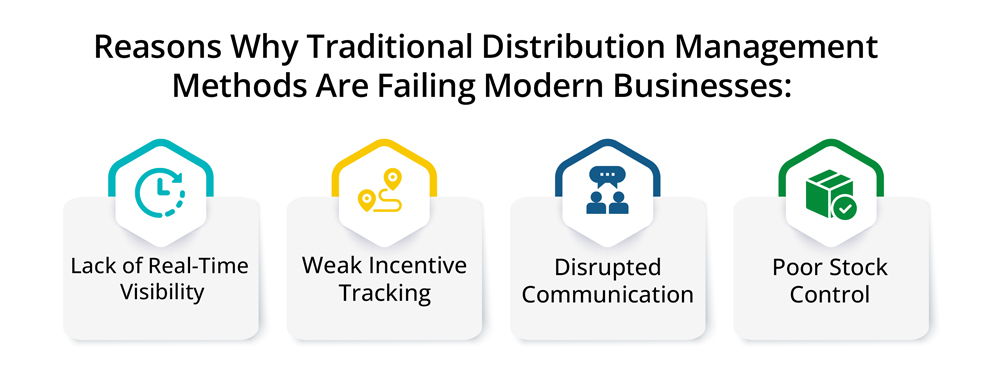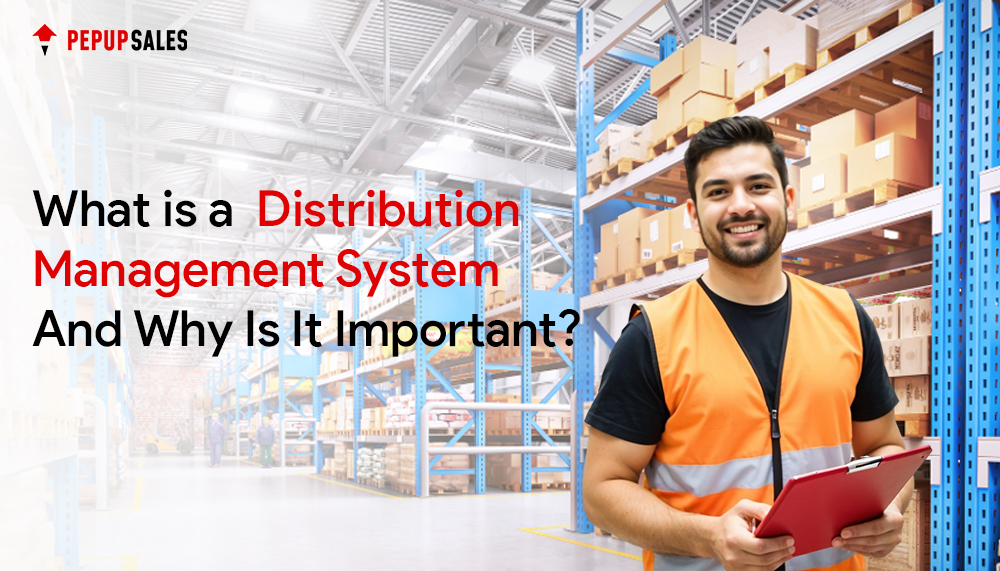Imagine you’re running a successful FMCG brand, and your products are flying off the shelves. Sounds great, right? But here’s the catch – while your products are selling well in some markets, they’re sitting idle in warehouses elsewhere. Your distributors keep ringing you with stock questions, payment wrangles are mounting and you no longer know which promotion programs are even effective.
Does this situation sound familiar? You are not the only one. Today, efficient flow of products in warehouses to retail shelves is not only a matter of logistics but also a matter of survival. As your supply chains increase, consumer demands fluctuate and you have distribution layers, trying to control your distribution network manually is like trying to play an orchestra but you are blindfolded.
This is where the Distribution Management System (DMS) comes to your rescue, think of it as the control center that will bring order to the madness of modern distribution.
Managing FMCG goods, pharmaceuticals, electronics or any other type of product, a powerful distribution management system will help your products flow smoothly through the supply chain, improving sales, minimizing waste and keeping your distribution partners engaged and motivated.
Let’s explore what makes a DMS so important to a modern business and how can you use it to change your distribution strategy?
What Is a Distribution Management System?
At its core, a distribution management system (DMS) is a comprehensive software solution that streamlines the entire distribution process – from order placement to final delivery. It is more than a simple software, a DMS is a strategic engine that can power your whole distribution ecosystem. It is more of a digital eco-system that links the brands, distributors, stockists, dealers and retailers on a single platform.
In simple terms, A DMS Software is like the WhatsApp of your supply chain, everyone is connected, information travels in real-time, and there is full visibility of what is going on, where and when.
The current DMS is not only a system that processes orders, but it is a system that links processes, people, and data in the entire distribution network. It offers in-time stock visibility, trade schemes and promotion campaigns digitalization, sales performance across territories tracking, claims and returns management, and most of all, it enables data-driven decision making. It is basically the digital spine of your route-to-market strategy, which ensures that the supply is able to meet the demand in an efficient manner and at the same time maintain profitability.
But here is the thing that makes a DMS so potent: it is created in such a way that it will be useful to all the parties of the distribution chain. As brands have more control and visibility, distributors have the benefits of easier ordering, scheme visibility and payment tracking. It is a win-win ecosystem that changes the conventional distribution relationships.
Why Your Business Needs a Distribution Management System
Let’s be brutally honest – managing distribution through spreadsheets, phone calls, and emails isn’t just outdated; it’s a business liability waiting to happen. Every day you delay implementing a proper DMS, you’re potentially losing sales, frustrating distributors, and missing opportunities to optimize your supply chain.
Here’s why traditional distribution management methods are failing modern businesses:

- Lack of real-time visibility: Without a DMS, you have no idea what’s happening after your products leave the warehouse.
- Disrupted communication: Traditional methods slow down collaboration between brands and distributors.
- Poor stock control: Overstocking or stockouts happen more frequently without an intelligent system.
- Weak incentive tracking: Distributors usually can’t see the entire scheme or do not see sales targets clearly.
A distributor management system closes all these gaps, enabling brands to implement their distribution strategy with precision, speed and control.
Key Features of a Distribution Management System
An effective distribution management system isn’t just about digitizing existing processes – it’s about reimagining how distribution should work in the digital age. Here are the essential features that separate good DMS solutions from great ones:
1. Intelligent Digital Order Management
Gone are the days when distributors had to call sales reps to place orders. A modern DMS allows distributors to place primary orders directly through web or mobile interfaces. But here’s where it gets interesting – AI-powered systems can suggest optimal order quantities based on historical data, seasonal patterns, and current stock levels. This means distributors are nudged to order smart, not just order more.
2. Real-time Stock Visibility Across the Network
Just imagine what it would be like to have a bird-view of your whole distribution network at any one time. An excellent DMS gives real-time view of stock in all the distributor outlets ensuring that the brands and distributors do not run out of stock or end up with excess stocks. Smart alarms provide information to the stakeholders before the problems happen so that they can act on time before they can occur.
3. Dynamic Scheme & Incentive Tracking
This is the area where DMS solutions really perform very well. The promotions and incentives used to trade are directly presented at the ordering point, so that distributors know exactly what they are earning. Tracking of the progress in real-time helps distributors know their progress towards the target and motivates them.
4. Comprehensive Claims & Returns Management
All distribution networks have to deal with claims of damaged goods, expired stock, scheme redemptions. This is simplified by the use of a centralized claims management portal whereby manual paperwork is minimized and resolutions are quickened.
5. Transparent Payment & Credit Tracking
Real time clear statements of accounts eliminate the chances of disputes over payments even before they arise. The distributors are able to get a clear picture of what they owe, what credits are due, and when payments are expected.
6. Advanced Analytics & Reporting
Modern distribution runs on data and a smart DMS converts raw data into actionable intelligence – as a refinery converts crude to fuel. Everything is measured, analyzed, and visualized: sales performance, fill rates, the activity of distributors, the effectiveness of schemes, so as to make better decisions.
Benefits of Using a Distribution Management System
Implementing a powerful distribution management system has wide-ranging benefits — not just for brands, but also for their channel partners.
For Brands:
- Smarter Inventory Management: Prevent stockouts and reduce wastage.
- Better Market Reach: Streamline supply across general trade, modern trade, and HoReCa channels.
- Increased Primary Sales: With digital nudges and visible schemes, distributors are more likely to place timely and larger orders.
- Data-Driven Decision Making: Real-time sales data helps brands adapt to market shifts quickly.
- Efficient Trade Promotions: Understand what promotions work and optimize spend.
For Distributors:
- Self-ordering Made Simple: No waiting for sales reps. Place orders anytime, anywhere.
- Scheme Visibility: Know exactly what incentives are on the table and how close they are to hitting targets.
- Transparency in Payments: Clear financial statements build trust and accountability.
- Reduced Manual Effort: Save time and effort through automation.
In short, a distribution management software transforms how businesses and distributors work together — creating a win-win ecosystem.
How to Implement a Distribution Management System
Implementing a DMS isn’t just about purchasing software – it’s about transforming your entire distribution approach. Here’s a proven roadmap for smooth implementation:
Phase 1: Define Clear Objectives
Begin by determining certain issues that you would like the DMS to address. Do you have inefficient fill rates, inventory discrepancies, low secondary sale tracking or distributor involvement problems? Clarity of goals will assist you to get the appropriate solution and gauge success.
Phase 2: Select a Scalable Flexible Solution
Choose a distribution management system that is scalable to your business and can be altered to fit other industries or processes. Seek out modular solutions that can be tailored without a lot of development effort.
Phase 3: Secure Distributor Buy-in
This is essential, your DMS must be adding value to distributors and not brands only. Such functions as self-ordering, real-time reporting, payment transparency, and scheme transparency are supposed to make the lives of distributors, rather than complicate them.
Phase 4: Ensure Seamless Integration
Your DMS ought to blend well with other established systems such as ERPs, accounting tools (such as Tally), and field sales applications. The flow of data must be smooth without the involvement of humans.
Phase 5: End to End Training & Support
Carry out thorough training sessions and provide continuous support during the transition phase. Remember that the secret to success is adoption.
Phase 6: Monitor, Measure and Optimize
Monitor the adoption level, order patterns, and sales increase after implementation using in-built analytics. The perpetual optimization will guarantee that you are getting the best of your investment.
Common Challenges and Solutions
Even the best distributor management systems can face hurdles. But these challenges are manageable when approached smartly.
| Challenge | Why It Happens | Solution |
| Manual order placement | Distributors still use calls/spreadsheets | Enable mobile/web-based ordering |
| Poor scheme visibility | Incentives not shown during ordering | Display trade promotions in real-time |
| Distributor resistance | They see DMS as brand-focused | Offer benefits like self-ordering, insights |
| Payment disputes | Lack of transparent statements | Provide clear digital account summaries |
| Stock mismanagement | No real-time tracking | Enable smart stock alerts & low-stock nudges |
| Limited access | System not mobile-friendly | Provide mobile-optimized interfaces |
These challenges can be easily overcome by selecting the right platform and making sure that it is value additive to both brand and distributor.

Conclusion
The distribution models of businesses are evolving rapidly, and those businesses that cannot keep up will be left behind. The use of a powerful distribution management system is not an option anymore but a requirement to any brand that uses distributors, stockists, and dealers to distribute its products.
At PepUpSales, we understand the challenges brands face in managing large, multi-tiered distribution networks. That’s why our distribution management system is designed with both the brand and distributor in mind — easy to use, mobile-accessible, scalable, and fully integrated with your existing workflows.
Whether you’re an FMCG brand, a consumer goods manufacturer, or operating in pharmaceuticals or retail, PepUpSales helps you streamline every aspect of your distribution. Ready to make your distribution smarter, faster, and more efficient?
Schedule your free demo with PepUpSales today and see the difference a modern distribution management system can make for your business.

